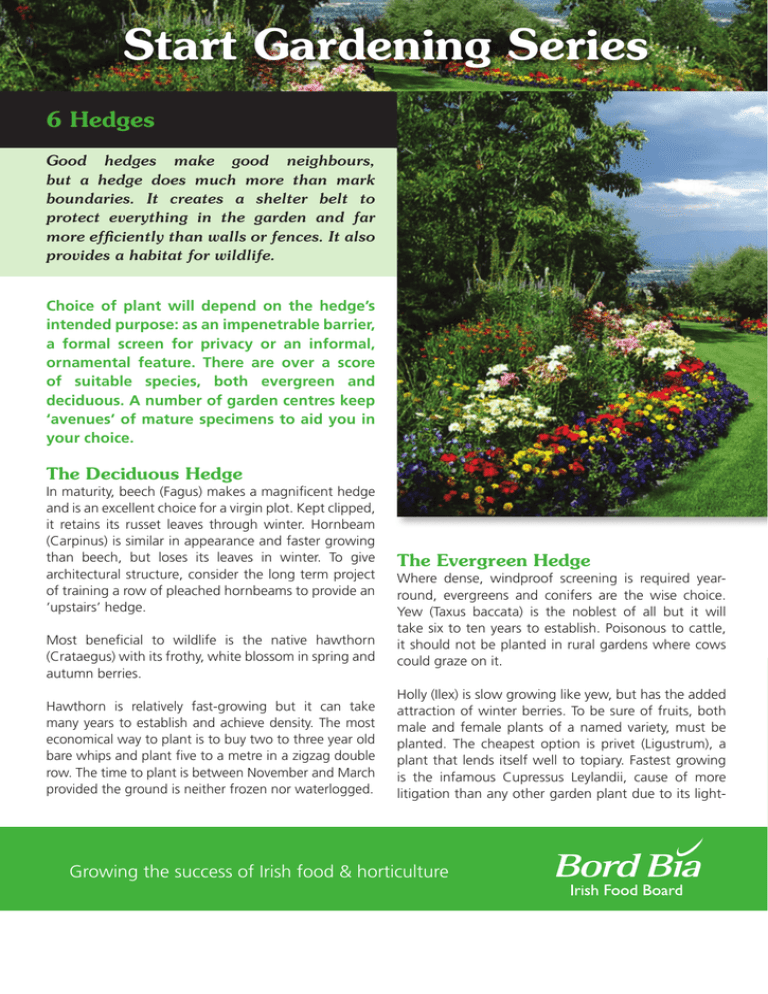Start Gardening Series 6 Hedges
advertisement

Start Gardening Series 6 Hedges Good hedges make good neighbours, but a hedge does much more than mark boundaries. It creates a shelter belt to protect everything in the garden and far more efficiently than walls or fences. It also provides a habitat for wildlife. Choice of plant will depend on the hedge’s intended purpose: as an impenetrable barrier, a formal screen for privacy or an informal, ornamental feature. There are over a score of suitable species, both evergreen and deciduous. A number of garden centres keep ‘avenues’ of mature specimens to aid you in your choice. The Deciduous Hedge In maturity, beech (Fagus) makes a magnificent hedge and is an excellent choice for a virgin plot. Kept clipped, it retains its russet leaves through winter. Hornbeam (Carpinus) is similar in appearance and faster growing than beech, but loses its leaves in winter. To give architectural structure, consider the long term project of training a row of pleached hornbeams to provide an ‘upstairs’ hedge. Most beneficial to wildlife is the native hawthorn (Crataegus) with its frothy, white blossom in spring and autumn berries. Hawthorn is relatively fast-growing but it can take many years to establish and achieve density. The most economical way to plant is to buy two to three year old bare whips and plant five to a metre in a zigzag double row. The time to plant is between November and March provided the ground is neither frozen nor waterlogged. The Evergreen Hedge Where dense, windproof screening is required yearround, evergreens and conifers are the wise choice. Yew (Taxus baccata) is the noblest of all but it will take six to ten years to establish. Poisonous to cattle, it should not be planted in rural gardens where cows could graze on it. Holly (Ilex) is slow growing like yew, but has the added attraction of winter berries. To be sure of fruits, both male and female plants of a named variety, must be planted. The cheapest option is privet (Ligustrum), a plant that lends itself well to topiary. Fastest growing is the infamous Cupressus Leylandii, cause of more litigation than any other garden plant due to its light- Growing the success of Irish food & horticulture Start Gardening Series 6 Hedges blocking, phenomenal growth (4ft a year) and dull appearance. If you are bent on having it, choose cultivars of contrasting colours to counteract its drabness. Chamaecyparis lawsonia ‘Allumii’ is similar in appearance but of less rampant habit. The Ornamental Hedge A tapestry hedge is one of the most attractive ways to achieve a boundary. It combines compatible species of similar growth rates and can comprise both evergreen and deciduous cultivars, such as yew, holly and beech. For a lowgrowing, ornamental hedge, rosemary and lavender are aromatic options. Informal hedge plants with berries include pyracantha and cotoneaster. In a sunny situation roses can make a splendid, if uneven, hedge. Essential requirements are found in a number of varieties such as Rosa rugosa which is hardy, disease resistant, repeat flowering and thorny. The Bamboo Hedge For a hedge with a difference, there are several types of bamboo that are ideal for the purpose, particularly in areas where soil moisture is high. Although native to every continent except Europe, most in cultivation hail from the Orient. They were first introduced to Europe in the mid nineteenth century since when some species have become naturalised in Ireland. Members of the grass family, they range from dwarf (10 cm high) to giant (15 metres high). Hardy and evergreen, they can be grown in most soil types. Varieties recommended as hedging include the wind resistant Pseudosasa japonica with olive green culms and deep green, glossy leaves; Fargesia murieliae ‘Jumbo’ with green canes and delicate green foliage; the dense, fast growing Phyllostachys bissettii with shiny green culms and dark green leaves and the tall, hardy Semiarundinaria fastuosa. For a tiny garden, Fargesia murieliae ‘Bimbo’ rarely grows taller than a metre and is happy in both sun and light shade. Care of your Hedge Most hedges are planted bare rooted November to March, with planting technique similar to that for trees and shrubs. Prepare the ground by working in compost or well-rotted manure to a trench wide enough to take the spread of the roots. For a dense hedge, plant a double, staggered row with plants 30–60cm apart. They should be soaked for 30 minutes before planting. In the case of containerised specimens, if the roots have become compacted they should be gently teased out before planting. Growing the success









